Customization
Most fountain pens are provided with standard stock nibs ranging in size from Fine to Medium to Broad, with Extra-Fine, Double-Broad, Stub, and Music sizes also common (experienced pen users can check out our tipping sizes page for exact comparisons among the pen lines we carry).
Most stock nibs are designed to give a consistent, unvarying line. But some users, such as artists, calligraphers, or just anyone who wants to add more personality and distinctiveness to their writing, are attracted to fountain pens precisely for the ability to use customized nibs which provide for varying line-widths.
If you are happy with a consistent, unvarying line with your pen, then most likely you will not have any immediate need for a customization. But if you want to achieve line-width variation, you will most likely be considering a customization to Stub, Italic, or Oblique points, and possibly considering adding flex as well. Other customizations can be as simple as a regrind, to make a broader nib more fine, or, less commonly, a retip, to make a finer nib more broad.
In general, the broader the nib point you start from, the more line-width variation you’ll see after customization. These customizations provide for more creativity and individuality in a pen-user’s writing - but they can also be more demanding in terms of the user’s ability to control and handle the pen.
Difference Between Stub, Italic & Oblique
A stub tip is cut straight across the top and is the easiest to use of the three, since it has somewhat rounded edges and corners. A cursive italic point is similar to a stub except sharper, giving more line-width variation between the vertical and horizontal strokes. It is also more position sensitive, however; the sharper and narrower the point, the less smooth it will feel on paper. By contrast, a rounder stub will feel smoother, but not have as distinct a difference between the thin horizontal and broader vertical strokes. See our Stub or Italic pages for samples and more detailed information.
The oblique tip is cut at an angle, usually about 15 degrees, normally from top right to lower left, looking like ones left foot from the top. This is usually called a Left Oblique. Unfortunately, some companies, including Parker Pen, call this a Right Oblique. A true Right Oblique point, also called a Reverse Oblique, has a slant exactly the opposite of a Left Oblique and is used by only a few right-handed writers.
An oblique delivers more subtle line-width variation than stubs and italics because the broadest stroke is the upper-left-to-lower-right diagonal, and if your writing style is typical of most right-handed writers, your characters will have few of these strokes. John loves a left oblique point, but he is also used to the rotation required (the pen must be rotated to the left in order to find the point's "sweet spot"). See our Oblique page for samples and more detailed information.
Broader Nibs For Best Results
We don't recommend starting with anything finer than a Medium nib for customization to either italic or oblique. A narrower point would be very position-sensitive, require an extremely light touch from a slow and deliberate hand, and would still tend to be scratchy and not show very much line-width variation. In general, the broader the nib that you start from, the greater is the line-width variation that can result from customization
Customizations Guide
The below guide illustrates the differences between a standard, unmodified nib and its customized variations.
-
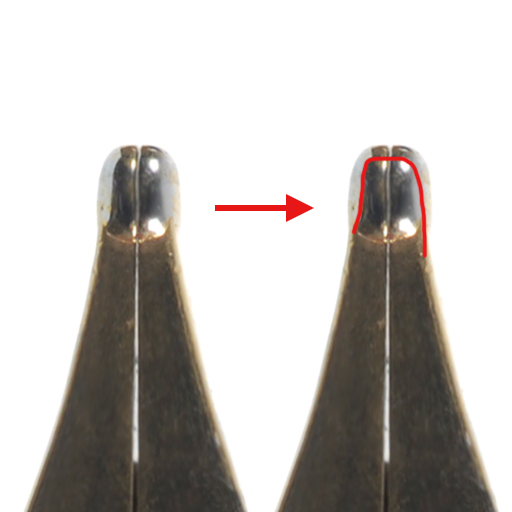
Resizing
A resize is necessary when the existing tipping is not as broad as that which is desired. For example, a customer would like to go from a Medium to a Broad or wider nib. In cases such as this, the existing tipping has to be physically removed and a new pellet must be welded onto the tines to accommodate the new tip. Any broader customization will require a resize.
-
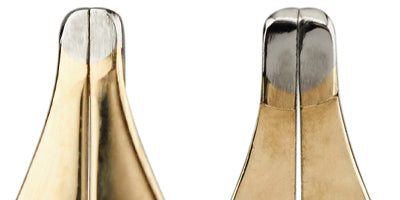
Stub
Above is the same size nib after a regrind to Stub. A regrind to Stub is often a good place to start for your first customization. A Stub nib provides broad down-strokes and narrow cross-strokes while writing, and is less position-sensitive on the paper than the crisper and slightly more demanding cursive italic.
-
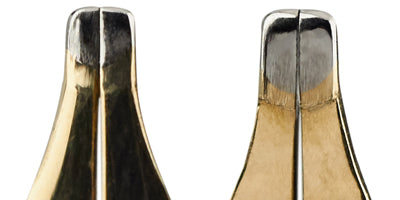
Cursive Italic
More demanding, but also providing crisper edges and more line-width variation, is the very popular customization to Cursive Italic. This also provides broad down-strokes and narrow cross-strokes, but is also more position-sensitive in terms of how the pen is held and requires more skill on the part of the user. This is a common customization for artists and calligraphers, but is still smooth enough to make for a good everyday writer.
-
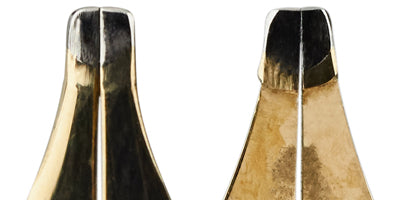
Formal Italic
Formal Italic is an even crisper and more demanding customization than either cursive italic or left oblique, and is usually utilized for calligraphy and by the most experienced users. This provides broad down-strokes and narrow cross-strokes, with even crisper corners and edges than a cursive italic - this is an extremely position-sensitive customization.
-
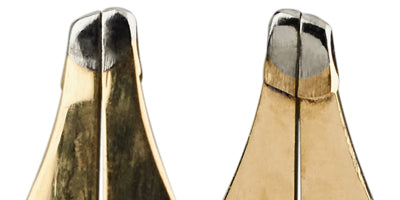
Left Oblique
Commonly used for signatures and correspondence, the Left Oblique customization provides broad diagonal strokes and narrow cross-strokes, and like a cursive italic, is more position-sensitive and demanding than a stub. The whole pen must be rotated to the left in order to write smoothly, without skipping. The "Left" in Left Oblique refers to the cut of the nib itself, and does not refer to the handedness of the writer.
-
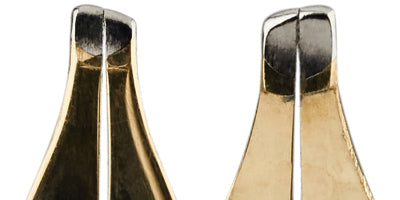
Reverse Oblique (uncommon)
Reverse Oblique is a rare form of customization that provides for the broadest stroke on the reverse diagonal. It is extremely position-sensitive and demanding on the skills of the writer; most pen owners will be much happier with customizations to Left Oblique or Cursive Italic. Some lefties like this one because it requires a clockwise rotation of the nib, making the top surface of the nib more visible to them while they write.
-
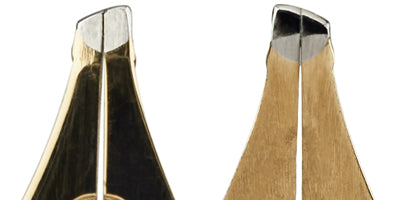
Flexible Oblique
Line-width variation can be also be achieved by adding Flex, which can be done with any size tipping point, though not with every brand of nib - see our FAQ on nibs suitable for flex for more details. Some pens, such as the Namiki Falcon and Metal Falcon, come standard with Soft nibs that are already semi-flexible. Any Nakaya pen can also be fitted with a stock Fine Soft or Soft Medium nib as well. Many experienced users have us add flex to these already semi-flexible nibs to achieve the most flexibility possible
-
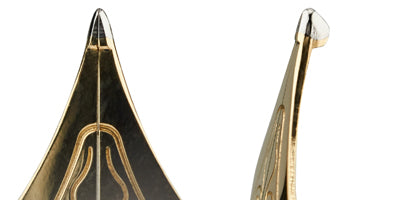
Architect's Point (Also for Arabic and Hebraic writing)
A more exotic regrind is that to Architect’s Point. Named after the style of writing used by Frank Lloyd Wright, this regrind is the opposite of cursive italic, and provides for broad cross-strokes and narrow down-strokes. This also tends to be a particularly useful customization for those practicing Arabic or Hebraic calligraphy.
-
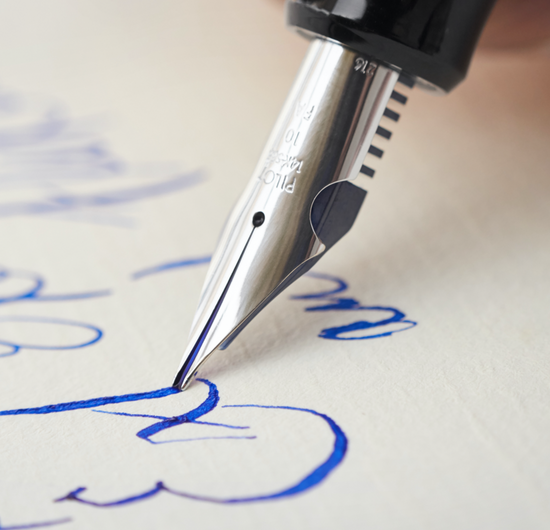
Spencerian
Perhaps our most popular customization, but also one of the most advanced, the Mottishaw Spencerian Customization has gained special attention from being featured in a customer's YouTube video which has now received over twelve million views! The Spencerian starts from a semi-soft 14k nib and adds additional flex and a regrind to needlepoint to create a specialized writing point used for copperplate calligraphy. For more details, visit our special Spencerian page.









